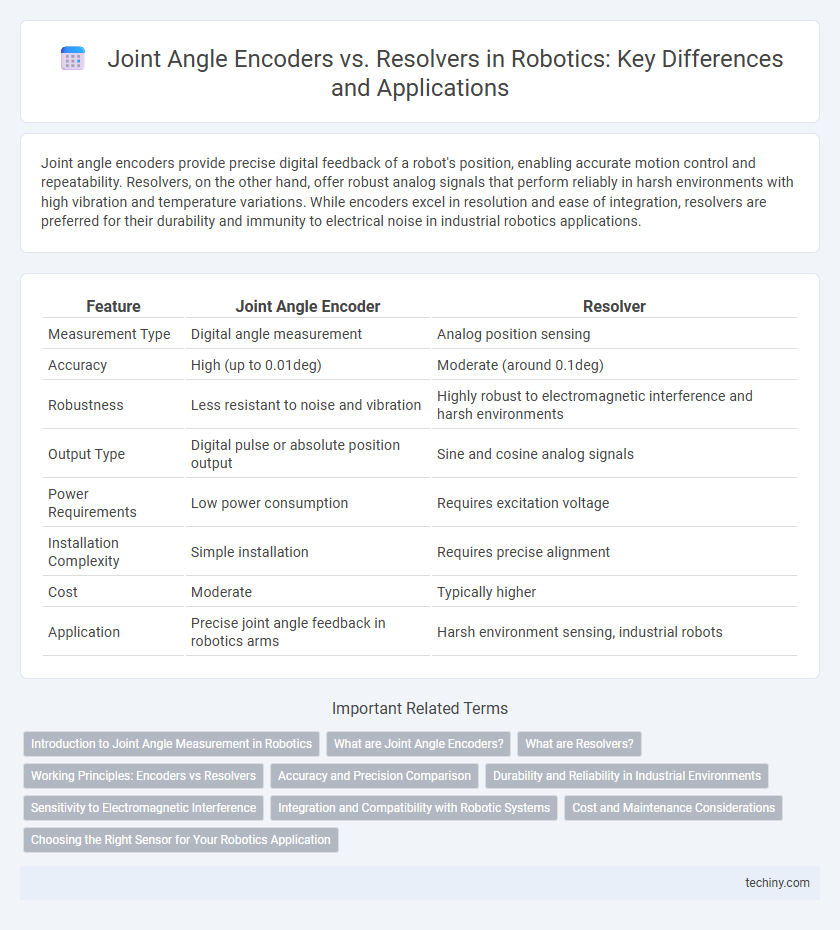Joint angle encoders provide precise digital feedback of a robot's position, enabling accurate motion control and repeatability. Resolvers, on the other hand, offer robust analog signals that perform reliably in harsh environments with high vibration and temperature variations. While encoders excel in resolution and ease of integration, resolvers are preferred for their durability and immunity to electrical noise in industrial robotics applications.
Table of Comparison
| Feature | Joint Angle Encoder | Resolver |
|---|---|---|
| Measurement Type | Digital angle measurement | Analog position sensing |
| Accuracy | High (up to 0.01deg) | Moderate (around 0.1deg) |
| Robustness | Less resistant to noise and vibration | Highly robust to electromagnetic interference and harsh environments |
| Output Type | Digital pulse or absolute position output | Sine and cosine analog signals |
| Power Requirements | Low power consumption | Requires excitation voltage |
| Installation Complexity | Simple installation | Requires precise alignment |
| Cost | Moderate | Typically higher |
| Application | Precise joint angle feedback in robotics arms | Harsh environment sensing, industrial robots |
Introduction to Joint Angle Measurement in Robotics
Joint angle encoders and resolvers are critical components in robotic joint angle measurement, enabling precise control of robot arm positioning. Encoders typically provide high-resolution digital signals for accurate angle feedback, while resolvers offer robust analog output resilient to harsh environments and electrical noise. Selecting the appropriate sensor depends on factors such as required accuracy, operating conditions, and system complexity in robotic applications.
What are Joint Angle Encoders?
Joint angle encoders are precision sensors used in robotic joints to measure angular position and rotational displacement with high accuracy. They convert mechanical motion into electrical signals, enabling precise control and feedback for robotic arm positioning. Unlike resolvers, joint angle encoders often provide digital output that facilitates easier integration with modern robotic control systems.
What are Resolvers?
Resolvers are rotary electrical transformers used in robotics to precisely measure the angular position and velocity of robot joints. They operate with analog signals and provide robust, noise-resistant feedback essential for accurate motion control in harsh industrial environments. Compared to joint angle encoders, resolvers offer higher durability and reliability, especially under extreme temperature, vibration, and electrical interference conditions.
Working Principles: Encoders vs Resolvers
Joint angle encoders use optical or magnetic sensors to convert mechanical rotation into electrical signals, offering precise digital output for exact position feedback in robotics. Resolvers operate on electromagnetic induction principles, generating analog signals proportional to angular position, which provides robust performance in harsh environments but requires complex signal processing. Both devices measure angular displacement, yet encoders deliver higher resolution and ease of integration, while resolvers excel in durability and reliability under extreme conditions.
Accuracy and Precision Comparison
Joint angle encoders provide high accuracy and precision by directly measuring the angular position through optical or magnetic sensors, offering resolutions up to 0.001 degrees. Resolvers, while robust and reliable in harsh environments, typically deliver lower precision with angular resolution around 0.01 degrees due to their analog signal nature and susceptibility to noise. For applications demanding fine positional control in robotics, encoders are preferred for their superior measurement accuracy and repeatability compared to resolvers.
Durability and Reliability in Industrial Environments
Resolvers exhibit superior durability and reliability in industrial environments due to their robust construction and immunity to electrical noise, ensuring consistent joint angle measurement under harsh conditions. Joint angle encoders, while precise, are more susceptible to wear and environmental contaminants, potentially leading to decreased accuracy and higher maintenance in heavy-duty applications. The resilience of resolvers in extreme temperatures, vibrations, and exposure to dust or moisture makes them the preferred choice for long-term operation in demanding robotic systems.
Sensitivity to Electromagnetic Interference
Joint angle encoders generally exhibit higher sensitivity to electromagnetic interference (EMI) compared to resolvers, which are inherently designed with robust EMI immunity due to their electromagnetic induction operation. Resolvers maintain accurate angular position feedback in environments with strong electromagnetic noise, making them ideal for industrial robotics applications where interference is prevalent. Encoders often require additional shielding and filtering measures to mitigate EMI effects and ensure reliable position sensing.
Integration and Compatibility with Robotic Systems
Joint angle encoders offer seamless integration with robotic systems due to their digital output and compatibility with common control interfaces, enabling precise position feedback and easy calibration. Resolvers, characterized by their robust analog signals, require specialized interface electronics but excel in harsh environments and high-temperature conditions, ensuring reliable operation in industrial robotics. Selecting between encoders and resolvers depends on system architecture, required accuracy, and environmental factors to optimize performance and maintain compatibility with robotic controllers.
Cost and Maintenance Considerations
Joint angle encoders typically offer lower upfront costs and simpler installation compared to resolvers, making them cost-effective for many robotics applications. While encoders may require more frequent maintenance or replacement due to their sensitivity to dust and electrical noise, resolvers boast exceptional durability and minimal upkeep even in harsh industrial environments. For long-term cost efficiency, resolvers provide a robust solution with reduced downtime and maintenance expenses, despite higher initial investment.
Choosing the Right Sensor for Your Robotics Application
Joint angle encoders provide high-resolution digital feedback crucial for precise robotic arm positioning, while resolvers offer robust performance in harsh environments with high temperature and vibration resistance. Selecting the right sensor depends on application requirements such as accuracy, durability, and environmental conditions; encoders excel in precision but are sensitive to contaminants, whereas resolvers deliver reliable operation with lower resolution. Consider factors like signal processing complexity, maintenance needs, and cost-effectiveness to optimize joint feedback control in robotics systems.
joint angle encoder vs resolvers Infographic

 techiny.com
techiny.com